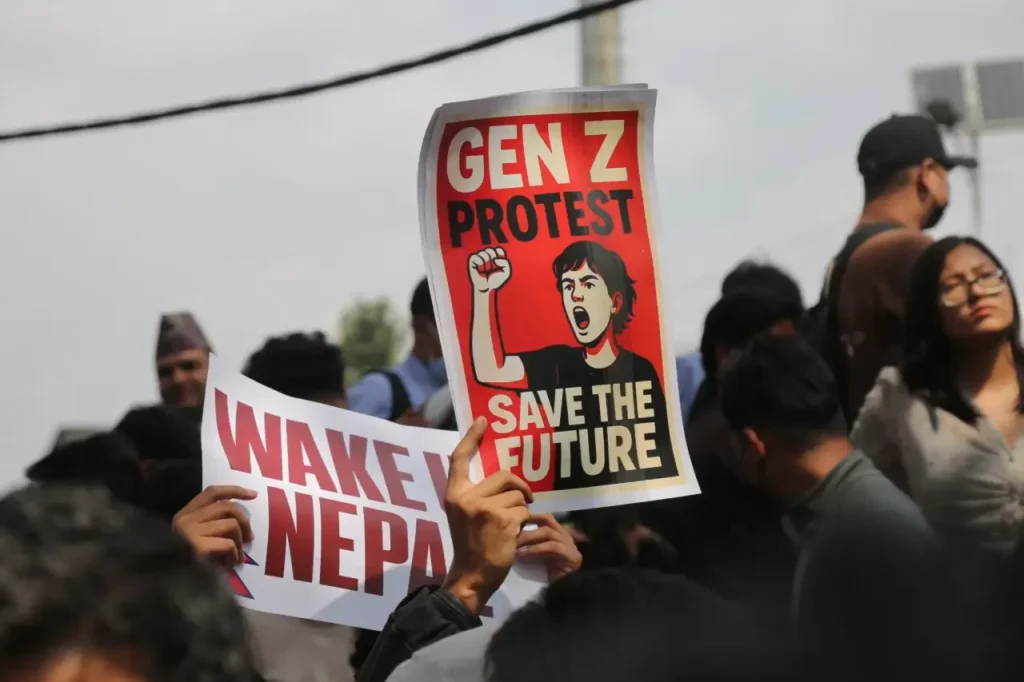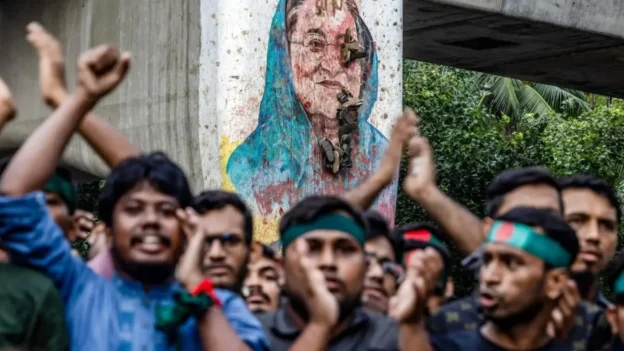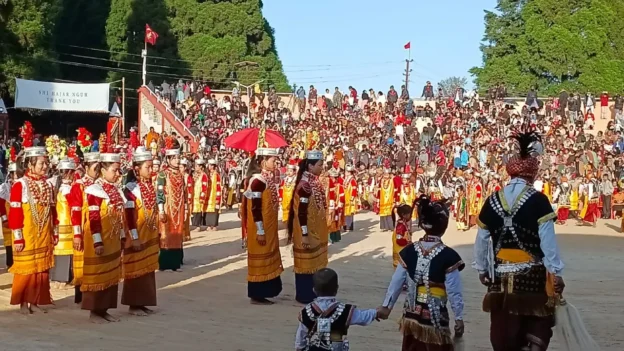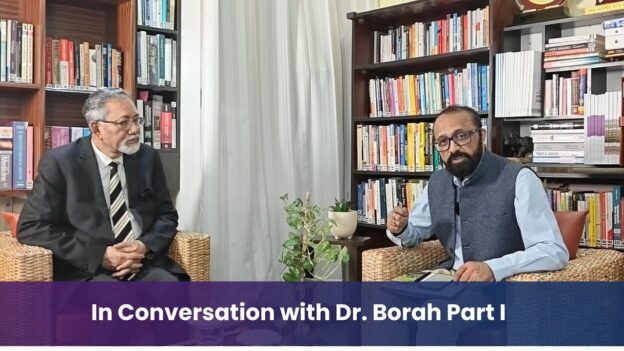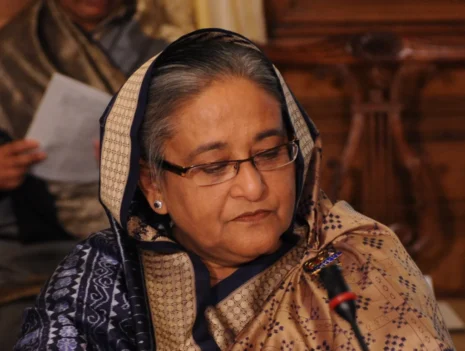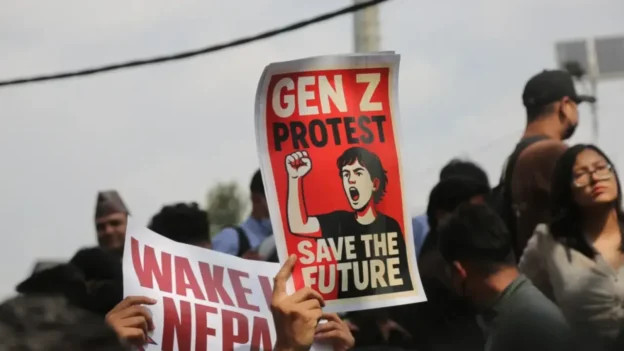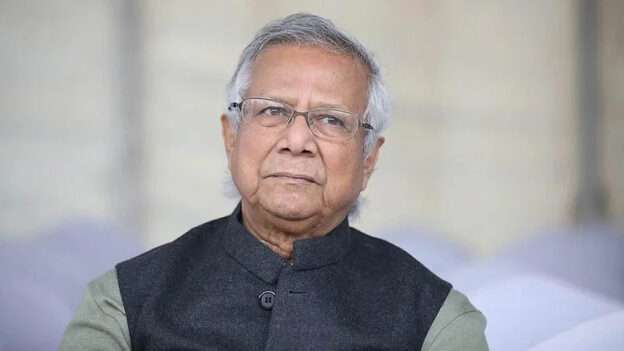Revolutions don’t typically drop down from the heavens; they’re constructed over years, on invisible tides and silent mobilizations. When Nepal exploded in September of 2025, the spectacle seemed spontaneous—tens of thousands of young Nepalis flooding into the streets of Kathmandu, their faces lit by the glow of phone screens, streaming chants and confrontations live. Within days, they overthrew Prime Minister K.P. Sharma Oli, burned the icons of governmental power, and installed an interim regime headed by ex-Chief Justice Sushila Karki.
To many, it seemed a simple outbreak of Generation Z indignation against censorship, corruption, incompetence, nepotism and favoritism. But as two flows of evidence now indicate—one followed through U.S. grant ledgers and the other through Nepal’s centuries-long susceptibility to foreign intervention—the uprising bore fingerprints that reached far into the distance from Kathmandu.
It started with a spark. On 4 September 2025, the Oli government announced a ban on 26 social media sites, from Facebook and X (formerly Twitter) to YouTube, LinkedIn, Reddit, and Signal, accusing them of failing to register under a new law. To officials of Nepal, this was presented as a regulation requirement; to average citizens, this seemed to be a deliberate gag order. The outrage went ballistic and, in a nation where smartphones were life-lines to information, news, and social connections, the ban struck to the very core of everyday life. By 9 September, the outrage had turned into nationwide uprising. The peaceful protests turned violent after police resorted to firing shots and killing dozens. The flames soon engulfed Singha Durbar, the Supreme Court, the Parliament and even the residence of the President. Under relentless pressure, Oli resigned.
And yet there appears to be evidence that this surge of organized indignation was not only the result of youthful resentment. It was the fruition of years of investment, training, and ideological supporting structures, much of it tied to American and allied organizations. Key to that story is Hami Nepal, an NGO that had started life way back in 2015 as an earthquake aid collective, handing out rice, medicine, and tents when the government failed to act. Under Sudan Gurung’s leadership, Hami Nepal earned its reputation during the pandemic crisis for its effective volunteer mobilization.
By 2025, however, it had evolved into something much more potent: a networked army of Gen-Z political activists capable of coordinating through Discord channels, using viral videos across multiple platforms, and staging protests with pinpoint timing. The key question, posed by a Rumble/New Atlas video “Who Is Behind Regime Change in Nepal and How to Follow the Money”, was how such an entity came to possess the sophistication and capacity to evolve from disaster response to political agitation. The answer, it posited, was to be found in cash, mentorship, and years of preparation.
The National Endowment for Democracy (NED), an American foundation established by Congress in 1983 to provide funding to democracy-building efforts overseas, steps into the spotlight of this investigation. Its FY2024 Asia Grant Listings provide dazzling details. A $65,000 grant with the title Promoting Youth Civic Engagement and Movement Building was allotted to set up youth centers of civic education and outreach. Another, very much bigger, $135,000 entry funded Strengthening Youth Participation in Advocacy and Reform Campaigns, with specific allocations to training and coordination of young democracy movement activists. A $20,000 grant concentrated on Developing New Media Strategies in Support of Democracy and Human Rights, training young influencers on digital security and platform usage, while connecting global networks across boundaries.
In the meantime, $71,250 was spent on Strengthening Media Coverage of Democracy Issues to widen digital reporting and video coverage of governance and rights. Lastly, another round of $65,000 was aimed at Facilitating Access to Justice for Human Rights Defenders, establishing online legal support centers and documentation mechanisms. In addition to these, the Asia infographic within the FY24 pages of NED showed Nepal’s overall allotment to amount to $1,741,377, a substantial amount within the context of its limited civic space.
None of these entries say “regime change” outright. But when mapped against what unfolded in September, the overlap is striking. Discord-based organizing cells echo the movement building workshops. Viral protest videos mirror the new media strategies grants. Polished livestreams and citizen documentaries recall the strengthened media coverage line items. The digital safety trainings resonate with encrypted messaging groups that sustained protest communication. Taken together, these grants look less like unrelated workshops and more like scaffolding for a movement, quietly assembled and ready to be activated once a crisis broke.
Add to this financial setup the seal and sponsorship of key Nepali personalities. Sudan Gurung has referred to Barbara Adams Foundation and Dr. Sanduk Ruit as the “guardians” of Hami Nepal. Video clips have gone viral where Gurung says, “The Barbara Foundation and Dr Sanduk Ruit are like guardians for Hami Nepal. We do not do anything without consulting them.”
Although both the foundation and Dr Ruit subsequently released denials of taking part directly in protests. The Barbara Adams Foundation maintained its aid was pure humanitarian; Ruit claimed his involvement was mentoring during times of disaster relief and not political agitation. Nevertheless, previous collaborations, including combined Covid relief efforts and common platforms, gave Hami Nepal legitimacy and access to donor networks. Even while not cash flows for the protests themselves, those connections increased credibility and access.
Meanwhile, the uprising cannot be severed from Nepal’s longer experience of foreign involvement. Since the overthrow of the Rana regime in 2007 B.S., Nepali democracy has been influenced to an equal or greater extent by foreign forces as by domestic conflicts. In the early 1950s, newly independent India acted midwife to Nepal’s democratic aspirations, planting its own characters and influence within Kathmandu. In the 1960s and 70s, King Mahendra’s suppression of Khampa rebels showed an unusual flash of sovereign initiative, but against the backdrop of Beijing, New Delhi, and Washington all applying pressure to Kathmandu about Tibet. During the Cold War period, Soviet investment represented a short-lived alternative, only to disappear with the collapse of the USSR. By the early 2000s, Western capitals increasingly saw Nepal through the strategic prism of India, linking Kathmandu’s destiny to the wider chessboard of South Asia.
The ostensibly “historic agreement” of 2006, whereby Maoist insurgency and monarchic rule were ended, was cheered overseas as democratic advancement. But in practice, instability took root. Federalism divided resources and intensified ethnic divisions, and sovereignty proved elusive. The bloody palace massacre of 2001, the ten-year insurgency, and the elimination of the monarchy left the army the sole protector of national sovereignty. But by 2025, even this institution seemed frozen. When Singha Durbar was torched and the Supreme Court stormed by protesters, troops stationed nearby did nothing, invoking rules of engagement. Their passivity seemed to many to epitomize hollowing of sovereignty: down went the monarchy, into passivity went the barracks, and legitimacy seemed to reside elsewhere—among the foreign arbiters.
Enter Washington. The Sunday Guardian news investigation conducted after the revolt revealed U.S. and aid-agency documents, combined with evidence of whistleblowers, of more than $900 million of U.S.-related assistance to Nepal since 2020. This included a May 2022 $402.7 million Development Objective Agreement signed with USAID, of which about $158 million had been spent by early 2025. The money, distributed across governance, civil society, digital resilience, and infrastructure, far outweighed the vast majority of other foreign commitments. They were made simultaneously with the Millennium Challenge Corporation compact, bilateral aid, and NGO programs. Whether conceived of as development aid or strategic influence, the size meant that Washington had a voice in Nepal’s civic structures, media discourse, and youth movements.
Commentators cited in the Guardian report cautioned that such resources might be wielded as leverage against local elites or directed to benefit one political stream over another. Their proponents argued them to be rightful investments. But against Nepal’s background, even innocent aid is viewed through the geopolitical lens. Indian primacy and dominance had been the norm; Chinese influence had expanded through investment and carrot-and-stick diplomacy but foundered on pressures from Tibet and Taiwan. By 2025, both giants of the neighborhood appeared abnormally debilitated—India engaged elsewhere, China on the defensive. Into the vacuum emerged the United States, not through troops or treaties, but through soft power: money, platforms, legitimacy.
The protest’s very cause—the ban on social media—spotlighted America’s subtle influence. Facebook, YouTube, and Instagram are not mere apps to young Nepalis; they represent lifelines, portals of identity, of opportunities, and of dissent. Stopping them meant attacking life itself. Washington’s indirect power here was colossal. American-owned platforms had radicalized a generation by being indispensable. When Oli banned them, he ignited not only a policy debate but a generational uprising.
Diplomatic responses firmed up the impression. Washington and its European partners promptly made statements supporting free speech and accountability. Sushila Karki’s appointment as interim leader was received enthusiastically across the seas, granting her government foreign legitimacy before local trust was fully established. By comparison, India came across uncertain and disoriented, while Beijing held its peace. For the first time in decades, New Delhi or Beijing were not the arbiters of legitimacy to be heard, rather Washington and Brussels seemed to arbitrate legitimacy in Kathmandu.
Whether this marks a permanent shift is uncertain. Nepal’s geography and history mean that India and China will always matter. Trade routes, borders, remittances, and security ties cannot be wished away. Yet, the rebellion has shown that in the 21st century, soft power—digital platforms, aid, international legitimacy—can matter as much as troops or treaties. In this arena, the United States now holds the upper hand.
This is not to say that the United States dictated the protests step by step. The fury was genuine: unemployment and corruption and despair over many years had radicalized Nepali youth. But the equipment, the training, the narratives—every one of them wore the mark of years of Western advocacy. The chants of internet freedom, transparency, and democracy were phrases touted by American grants and training sessions. The sleek livestreams were reminiscent of media-strengthening initiatives. Even the questions of legitimacy—who was acceptable to rule, who was “internationally” approved—were played out in Western capitals.
Foreign-orchestration thesis critics are correct to observe that Hami Nepal’s donation records were transparent: admin costs were covered by volunteers, and aid money went to direct relief. Independent reporting verifies this, muddying tales of secret U.S. paymasters. The truth is multifaceted. Nepali complaints were legitimate. Foreign funding didn’t purchase protestors’ indignation, but foreign funding gave protestors the training and connections to effectively direct that indignation. This combination of local indignation and foreign supporting structure created a rebellion that overthrew Oli’s regime.
In the wider frame of Nepali history, the Gen-Z uprising is both continuity and disruption. Continuity, because foreign fingerprints again loom over internal turbulence. Disruption, because, for the first time, India and China were not the determining outside players; the United States was. Worth over $900 million, with digital media at the center of everyday life, with NED training grants cataloged down to the page number, Washington had become Nepal’s silent power broker. Whether this will be empowering to Nepali youth or risky is not yet decided. They’ve shaken Nepal’s corrupt elite, but by doing that, perhaps they’ve ushered open the door to a new period during which America, rather than Nepal’s neighbors, is the determinative outside player.
Revolutions, as the saying goes, arrive like storms. The September uprising was no exception. But storms have undercurrents. In Nepal’s case, those undercurrents can be traced—from the relief tents of 2015, to the pages of NED’s 2024 grant reports, to the $402 million USAID agreements, to the fiery nights of September 2025 when Kathmandu burned. The question is not whether America built the storm, but whether it shaped the currents that made it inevitable.

